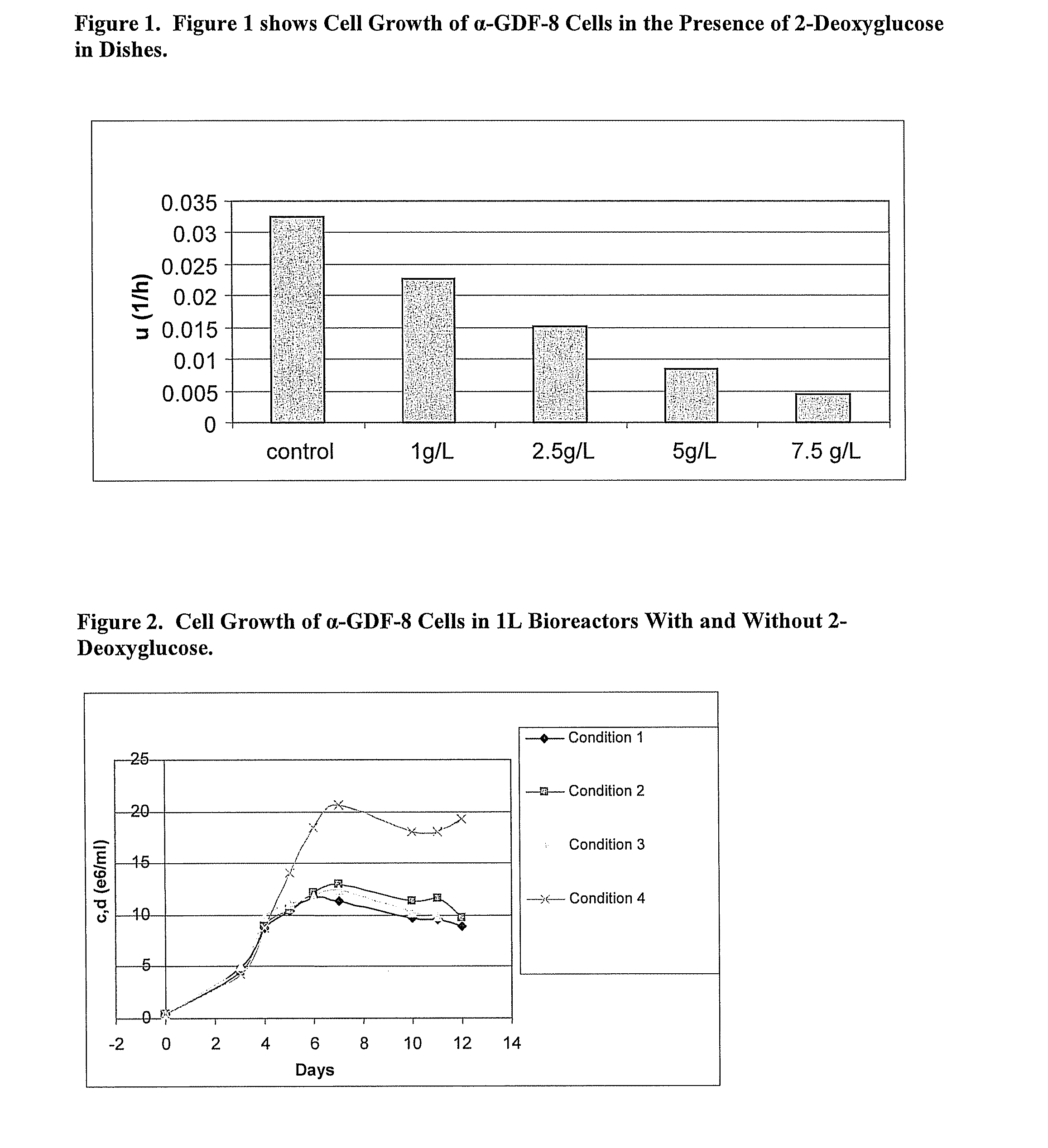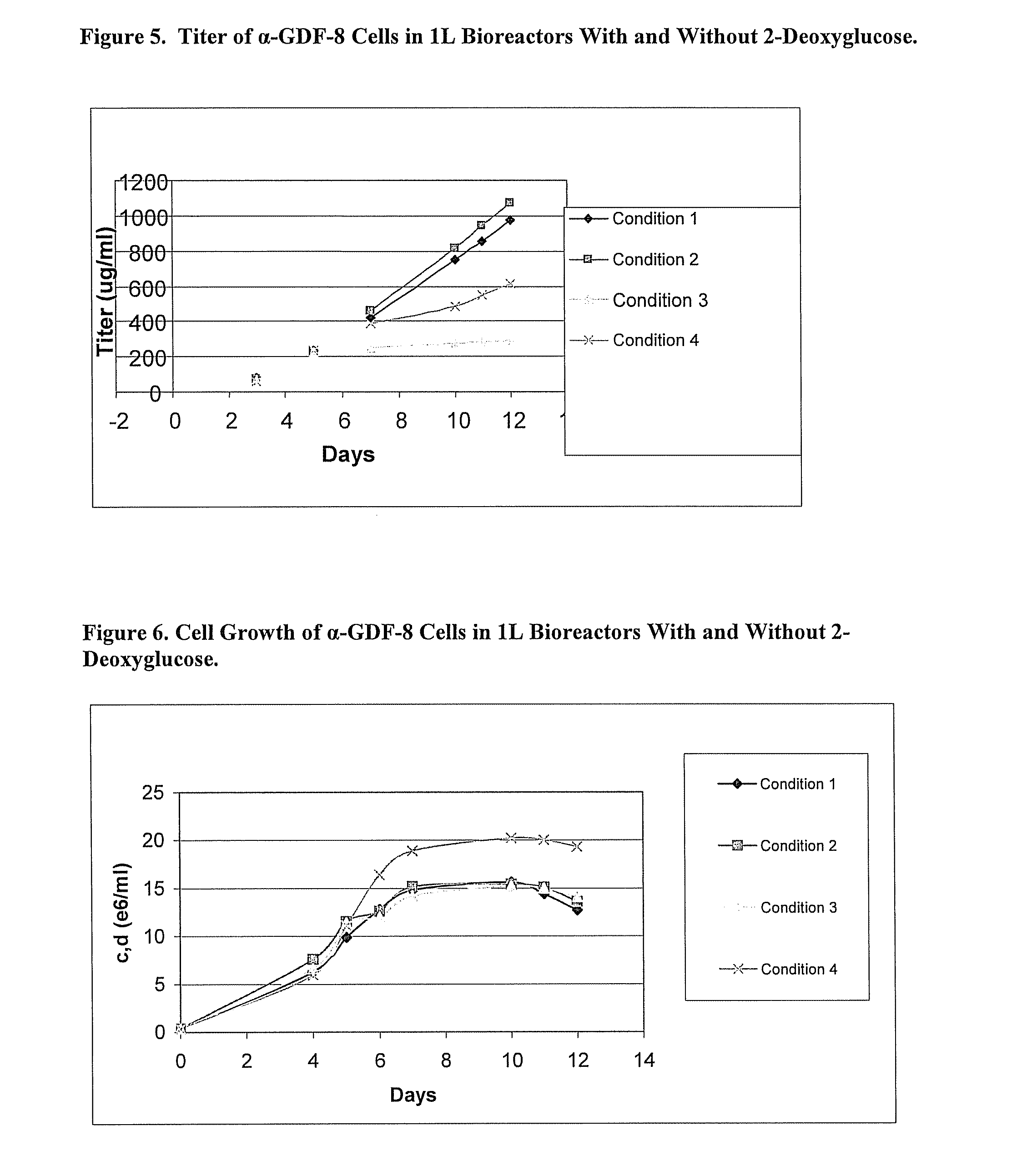Glycolysis-inhibiting substances in cell culture
a technology of glycolysis and cell culture, applied in the field of glycolysisinhibiting substances in cell culture, can solve the problems of reducing the production of metabolic waste products that have detrimental effects on cell growth or viability, and reducing the ph of the cell culture, so as to achieve high protein production and reduce accumulation
- Summary
- Abstract
- Description
- Claims
- Application Information
AI Technical Summary
Benefits of technology
Problems solved by technology
Method used
Image
Examples
example 1
Effect of 2-Deoxyglucose on Cell Growth of α-GDF-8 Cells in Culture Dishes
[0169]Introduction: Lactate is a known inhibitor of cell growth in cell culture (see Lao and Toth, Biotechnology. Prog. 13(5): 688-691, 1997). Decreasing the amount of glucose in cell culture leads to a concomitant decrease in the amount of lactate produced. 2-deoxyglucose is a structural analog of glucose in which the hydroxyl group at the 2′ position of the sugar is replaced with a hydrogen moiety. Roth et al. have demonstrated that 2-deoxyglucose reduces glucose / energy flux when fed to rats without decreasing their total food intake (Annals of the New York Academy of Sciences, 928:305-15, 2001). In this example, experiments were performed to determine whether the addition of 2-deoxyglucose to mammalian cell culture was detrimental to the growth of the cells in culture dishes.
[0170]Materials and Methods: Chinese Hamster Ovary (“CHO”) cells engineered to express a monoclonal antibody against growth and differ...
example 2
Effect of 2-Deoxyglucose on Lactate of α-GDF-8 Cells in Culture Dishes
[0173]Introduction: Example 1 demonstrated that cell cultures grown in culture dishes tolerated 2-deoxyglucose well when provided at low concentrations. In this example, experiments were performed to test whether the presence of 2-deoxyglucose had an effect on the accumulation of lactate in cell cultures grown in culture dishes.
[0174]Materials and Methods: α-GDF-8 cells were grown in culture dishes in Medium 1 containing approximately 6 g / L glucose with varying concentrations of 2-deoxyglucose. Some α-GDF-8 cultures were optionally supplemented with glucose to a final initial concentration of 9 g / L. Cells were passaged twice and grown for three days after each passage. At the end of three days, each of the passaged cultures was measured for viability, cell density, glucose levels, lactate levels and α-GDF-8 titer. Specific titer production rate (“Qp”) and specific lactate uptake rate (“Qlact”) were calculated. Qla...
example 3
Effect of 2-Deoxyglucose on Cell Growth and Productivity of α-GDF-8 Cells in Bioreactors
[0180]Introduction: Examples 1 and 2 demonstrated that cell cultures grown in culture dishes tolerated added 2-deoxyglucose well when provided at low concentrations and that lactate accumulation was decreased in the presence of 2-deoxyglucose. In this example, experiments were performed to determine whether 2-deoxyglucose decreased the amount of lactate produced during cell cultures grown in Bioreactors and whether the presence of 2-deoxyglucose had other beneficial or detrimental effects aside from the reduction in growth rate, particularly as the cell culture is grown for an extended period of time.
[0181]Materials and Methods: α-GDF-8 cells were grown in Medium 2 in 1 L Bioreactors and fed with Medium 3. The compositions of Medium 2 and Medium 3 are shown in Table 3. Some of the cultures were supplemented with 0.5 g / L 2-deoxyglucose at the beginning of the culture. The cultures were shifted fro...
PUM
| Property | Measurement | Unit |
|---|---|---|
| volume | aaaaa | aaaaa |
| volume | aaaaa | aaaaa |
| volume | aaaaa | aaaaa |
Abstract
Description
Claims
Application Information
 Login to View More
Login to View More - R&D
- Intellectual Property
- Life Sciences
- Materials
- Tech Scout
- Unparalleled Data Quality
- Higher Quality Content
- 60% Fewer Hallucinations
Browse by: Latest US Patents, China's latest patents, Technical Efficacy Thesaurus, Application Domain, Technology Topic, Popular Technical Reports.
© 2025 PatSnap. All rights reserved.Legal|Privacy policy|Modern Slavery Act Transparency Statement|Sitemap|About US| Contact US: help@patsnap.com



